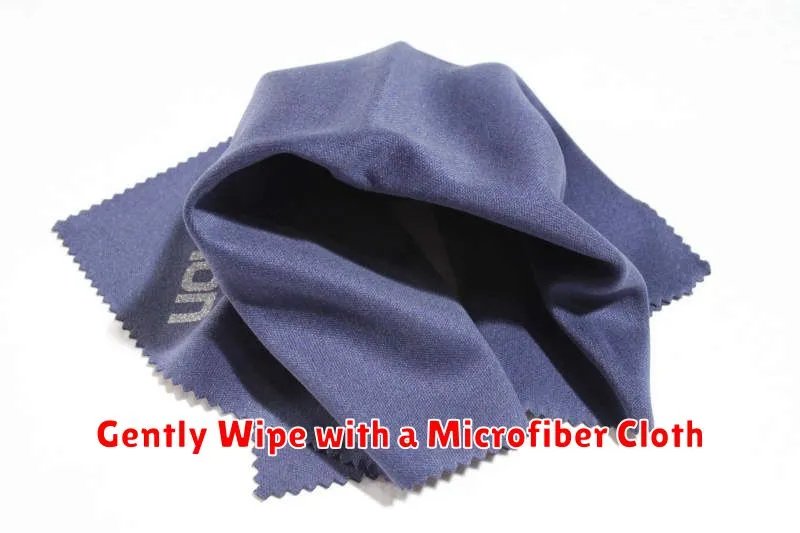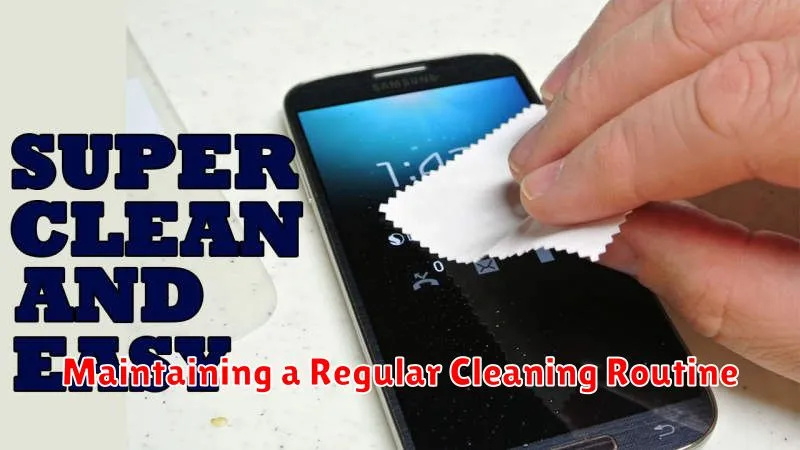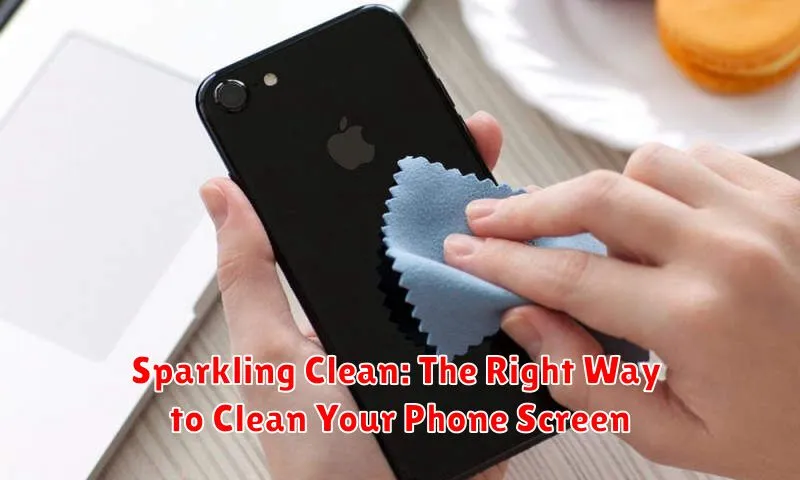Maintaining a sparkling clean phone screen is more important than you might think. Our phones are high-touch surfaces that accumulate dirt, germs, and fingerprints throughout the day. A clean phone screen not only enhances the viewing experience but also contributes to overall hygiene. This article will guide you through the right way to clean your phone screen, ensuring it stays pristine and germ-free. Learn how to effectively remove smudges, fingerprints, and bacteria without damaging your device. Discover the best way to clean your phone screen and keep it sparkling clean.
Cleaning your phone screen may seem straightforward, but using the wrong methods can lead to scratches or even damage the delicate oleophobic coating. Avoid harsh chemicals and abrasive materials that can compromise your screen’s integrity. This guide outlines safe and effective phone screen cleaning techniques, using readily available materials. Follow these simple steps for a sparkling clean phone screen that’s free of damage and looking its best. We’ll cover everything from the right way to clean your phone screen to the best way to clean your phone screen, ensuring a pristine and hygienic mobile experience.
Gather Your Cleaning Supplies
Before you begin cleaning your phone screen, it’s essential to gather the right supplies. Having everything prepared will ensure a smooth and effective cleaning process.
The most important tool is a high-quality microfiber cloth. These cloths are designed to be gentle on delicate surfaces like phone screens while effectively removing fingerprints and smudges. Avoid using abrasive cloths, paper towels, or tissues, as these can scratch the screen.
If you’re dealing with stubborn smudges, you may also need a small amount of distilled water. Tap water can sometimes contain minerals that can leave streaks. A fine-mist spray bottle can be helpful for applying the water evenly without over-saturating the cloth.
Power Off Your Phone
Before you begin cleaning your phone screen, power it off completely. This is a crucial safety precaution. It prevents accidental activation of functions while cleaning and eliminates the risk of short circuits if moisture were to enter the device.
Turning off the phone also allows you to clearly see the smudges and dirt on the screen against a dark background, making your cleaning efforts more effective. This step ensures a safer and more thorough cleaning process.
Gently Wipe with a Microfiber Cloth

With your phone powered off, take a clean, dry microfiber cloth. These cloths are ideal for cleaning electronics due to their soft, non-abrasive nature. They effectively remove dust, fingerprints, and smudges without scratching the delicate screen surface. Avoid using paper towels, tissues, or abrasive cloths as these can cause micro-scratches.
Gently wipe the entire surface of your phone screen in circular motions. Don’t apply excessive pressure. The microfiber cloth should do the work. Pay attention to the edges and corners where dust and debris often accumulate. Flip the cloth over to a clean side if one side becomes soiled.
Tackling Stubborn Smudges
Sometimes, a simple wipe with a microfiber cloth isn’t enough to remove stubborn fingerprints, grease, or dried-on residue. In these cases, slightly dampening the cloth can be effective.
Important: Never directly spray any liquid onto your phone screen. Instead, lightly moisten a clean section of your microfiber cloth with distilled water. Avoid tap water as it can contain minerals that might leave streaks or spots.
Gently wipe the affected area with the dampened portion of the cloth. For particularly persistent smudges, you might consider using a dedicated screen cleaning solution specifically designed for electronics. Always check the product label to ensure it is safe for your phone’s screen type. Apply the solution to the cloth, not directly to the screen.
After cleaning, use a dry section of the microfiber cloth to buff the screen until it is completely dry and streak-free.
Avoid Using Harsh Chemicals
Keeping your phone screen clean is essential, but using the wrong cleaning solutions can cause irreversible damage. Never use harsh chemicals like window cleaners, kitchen sprays, aerosol sprays, or abrasive powders on your phone’s screen. These substances can strip the oleophobic coating, which is designed to repel fingerprints and oil. Damage to this coating makes your screen more susceptible to smudges and scratches.
Similarly, avoid using products containing ammonia or bleach. These chemicals can discolor the screen and even damage the sensitive touch sensors underneath. Even seemingly harmless cleaning wipes may contain alcohol or other harsh chemicals that can be detrimental to your phone’s screen over time. Opting for the recommended cleaning methods will ensure a clean and undamaged screen.
Chemicals to Avoid:
- Window Cleaners
- Kitchen Degreasers
- Aerosol Sprays
- Abrasive Powders
- Ammonia-based Cleaners
- Bleach-based Cleaners
- Alcohol-based Cleaners (in high concentrations)
Cleaning Your Phone Case
Just like your phone screen, your phone case can accumulate dirt, grime, and bacteria. Regular cleaning is essential to maintain hygiene and prolong the case’s lifespan.
The cleaning method depends on the case material. For plastic and silicone cases, a simple solution of warm water and mild dish soap is effective. Remove the case from your phone and wash it with the soapy water, using a soft-bristled brush to scrub away dirt. Rinse thoroughly and dry completely before putting it back on your phone.
Leather cases require more specialized care. Use a damp cloth with a small amount of leather cleaner. Gently wipe the surface and avoid soaking the leather. After cleaning, apply a leather conditioner to keep the material supple.
For tough stains or buildup on any case material, try creating a paste of baking soda and water. Apply the paste to the affected area and gently scrub with a soft brush. Rinse and dry thoroughly.
Protecting Your Screen with a Screen Protector
A screen protector acts as a sacrificial barrier against scratches and scuffs that can accumulate on your phone’s screen. Several types of screen protectors are available, including tempered glass, PET film, and TPU. Each offers varying levels of protection.
Tempered glass protectors offer excellent scratch resistance and can even absorb some impact, helping prevent cracks to the underlying screen. PET film protectors are generally thinner and more affordable, providing decent scratch protection. TPU protectors offer a balance of flexibility, scratch resistance, and impact absorption.
When applying a screen protector, ensure your screen is thoroughly cleaned beforehand. Follow the manufacturer’s instructions carefully. Align the protector precisely and carefully apply it to avoid air bubbles. If bubbles appear, gently push them outwards with a microfiber cloth.
While a screen protector adds a layer of defense, it’s important to remember that they aren’t indestructible. Regularly inspect the protector for damage and replace it if necessary to maintain optimal screen protection.
Maintaining a Regular Cleaning Routine

Establishing a regular cleaning routine is crucial for keeping your phone screen pristine. Frequent cleaning prevents the buildup of grime and germs, ensuring optimal clarity and hygiene. A quick wipe down once a day can make a significant difference.
Consider incorporating phone screen cleaning into your existing daily routines, such as wiping it down after brushing your teeth in the morning or before bed. This helps to establish a habit and keeps your phone consistently clean.
Weekly deeper cleans can also be beneficial. This might involve using a slightly damp microfiber cloth for a more thorough cleaning, paying particular attention to the edges and corners of the screen.
By following a regular cleaning schedule, you can ensure your phone screen remains sparkling clean and free from potentially harmful bacteria.

